
Noisy neighborhood? Try these tactics.
While you can’t totally block out noise, several noise reduction strategies exist that can go a lot way toward mitigating noisy surrounding to make them less bothersome.
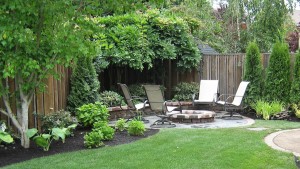 Did you know you can absorb sound with plants of all sorts? Their leaves, branches, and wood entrap the vibrations. Best when employed as close to the noise source as possible, this method is commonly used for large scale applications.
Did you know you can absorb sound with plants of all sorts? Their leaves, branches, and wood entrap the vibrations. Best when employed as close to the noise source as possible, this method is commonly used for large scale applications.
Trees with rough bark are effective at scattering sound waves. Deciduous plants lose their effectiveness when leaves fall, but leaf out for maximum advantage during the months when windows are open and you’re spending more time outdoors.
Hedges for Noise Reduction
Consider planting hedges in order to create a noise barrier. These plants can create dense screening between you and your neighbors and outdoor noises that may interfere with enjoying your landscape.
Partitions can cause sounds to be bounced away from the recipient and sometimes back toward the source.
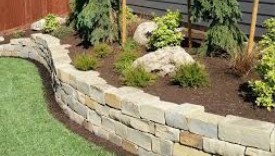 When sound waves strike a 5- or 6-foot masonry wall, it does not vibrate and they are reflected back toward the source. The sound waves that are higher up travel across the wall more readily, which is why plants along the wall and/or vines that grow over the wall enhance its effectiveness.
When sound waves strike a 5- or 6-foot masonry wall, it does not vibrate and they are reflected back toward the source. The sound waves that are higher up travel across the wall more readily, which is why plants along the wall and/or vines that grow over the wall enhance its effectiveness.
When sound waves strike a slightly flexible panel it will vibrate. This transforms sound waves into other forms of energy and deflects them in different directions. The more flexible the material, the greater the deflection. Common materials are fiberglass and corrugated metal.
White noise
If a room is empty with a bare floor and walls, every sound bounces off the hard surfaces to magnify it or even cause a slight echo as it bounces around. Add carpeting and the echo vanishes. On the ground plane the most powerful tool is a lawn, due to its large area and excellent refraction ability.
 Fountains and other water features provide a pleasant ‘white noise’ that is appealing to the human brain as a mask for undesirable noise. The most widely used method is a fountain that makes loud splashes. Coupled with other noise-reducing methods, even a smaller fountain becomes far more effective than you might think.
Fountains and other water features provide a pleasant ‘white noise’ that is appealing to the human brain as a mask for undesirable noise. The most widely used method is a fountain that makes loud splashes. Coupled with other noise-reducing methods, even a smaller fountain becomes far more effective than you might think.
Working with a professional landscaper will help you get the most out of your efforts. Walls, lawns, plantings and landscape installation are among the expert landscaping services Frontier Landscaping is proud to provide.
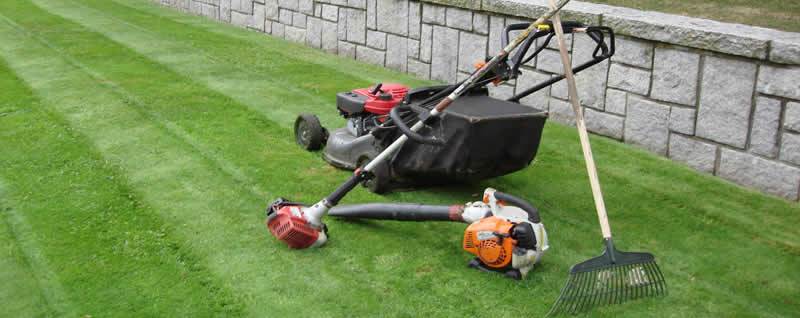
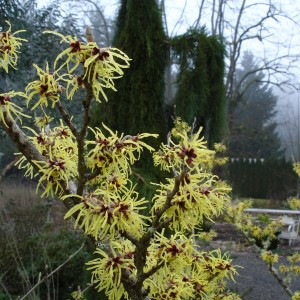
Capricious as March may be in her whims of weather, taking on a few of these spring garden tasks – even if between showers – will spruce up your landscape and lay the groundwork for a great growing season.
A clean sweep of decluttering, purging and tidying now will reward you with a fresh palette and greater options going forward.
Remove dead, damaged branches
Tree and shrub branches that have been damaged by cold, snow and wind should be pruned back to live stems; use a handsaw for any larger than ½ inch in diameter.
Prune (some) shrubs
While it’s a good time to prune summer-flowering shrubs, such as Rose of Sharon, before buds swell, the ideal time to prune spring bloomers is right after they flower. However, you can also prune them while in flower and use the flowering stalks in arrangements for inside. Forsythia and lilacs are wonderful examples.
Prune roses
Cut back winter-damaged rose canes to 1 inch below the blackened area. On climbers, keep younger green canes and remove older woody ones; neaten them up by bending the canes horizontally and tipping buds downward. Use jute twine or gentle Velcro fasteners to hold the canes in place. This task is best accomplished with a pair of sharp bypass pruners – and good gloves!
Divide perennials
Prune flowering perennials to a height of 4-5 inches to allow new growth to shoot up. Where soil has thawed, dig up overgrown clumps of perennials, such as daylily and hosta, dividing them into smaller clumps to be shared or transplanted elsewhere.
Clear the decks
Rake fallen leaves and dead foliage from around the base of your plants; they can smother plants and foster disease. Pull up weeds and spent annuals and rake away existing mulch to make way for a new layer after spring planting. Use pins to fasten loose drip irrigation lines and a square-head shovel to give beds a clean edge and keep turf grass from growing into them.
Feed
Now is a good time to spread a pelletized fertilizer on the soil’s surface so that spring rains can carry it to the roots. Add 5-10-10 fertilizer around bulbs as soon as they flower to maximize bloom time and nourish next year’s growth.
Compost yard waste
A compost pile can be as simple as a small corral made by joining a section of wire fencing. Collected leaves, cuttings, spent foliage and other debris will decompose and create nutrient rich humus for amending your garden. Branches larger than 1/2 inch in diameter should be cut down or chipped to accelerate decomposition or add a bagged compost starter to the pile. Keep the pile as moist as a wrung-out sponge and aerate it with a pitchfork every two weeks. Early spring weeds may keep growing and go to seed. These and chemically treated plant material should be otherwise disposed of.
Prep lawn for spring seeding
Test your soil’s pH in various locations where your lawn will be and assemble the right amendments. Remove damaged, diseased turf to prepare for the seeding that should follow in a few weeks. You can remove dead turf with a square metal rake, then flip it over to spread compost. Work in a half-inch layer of compost to keep the new seed moist and increase the germination rate. Begin seeding once the forsythia starts blooming in your area.
 Clean up paths & patios
Clean up paths & patios
Rake escaped gravel back into aggregate walkways and patios and order more to spread in large depressions that often form near the driveway’s apron. Refill joints between flagstones by sweeping in new sand or stone dust; water with a hose to set it, then repeat. If the freeze-thaw cycle has heaved pavers out of place, remove them and replenish the base material as needed before setting pavers back in. Use a pressure washer with a low pressure tip to remove slippery algae spots or leaf stains from patios and walkways.
Restore worn wood fences
Remove badly rotted or damaged pickets, boards or lattice and scrub wood structures with a mixture of 2 gallons water, 2 quarts bleach and 1 cup liquid soap; let dry. Patch rotted sections with wood epoxy; install new wood as needed. Check wobbly fence posts to see if they need replacing. Scrape off old paint, then sand with 60 grit sandpaper to prep for a new finish coat. Once temperatures go above 50 degrees F, brush on a new coat of paint or stain.
Choose Frontier Landscaping for help with your spring landscape cleanup. We are based in Vancouver, Wash., and provide services in the Portland-Vancouver area and throughout Clark County, Washington.
Call today to find out how Frontier Landscaping can grant you the yard you’ve been wishing for.
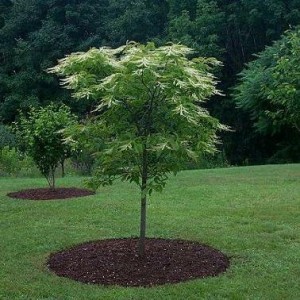
With its modest profile and year-round interest,
Oxydendrum arboreum – known commonly as sourwood – is one of the great trees for small spaces with a history of healing. The oval-shaped tree grows 20-25 feet tall.
The winter interest of many trees includes interesting bark and sourwood doesn’t disappoint. As the tree matures the bark becomes gray, ridged and scaly. Pioneers used to chew sourwood bark for mouth pain, draw its sap to relieve fever and brewed leaf tea for digestive maladies. Today sorrel leaf tea is widely used to slake the thirst of mountain climbers.
In spring the branches take a back seat to glossy green leaves 5-8 inches long and sour to the taste, hence the tree’s common name.
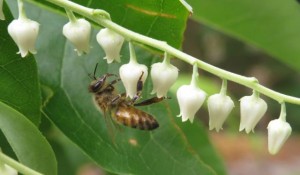
Summer ushers in drooping 4 to 8-inch clusters of waxy, fragrant white blooms very much like lily-of-the-valley. These are enticing to bees and in areas where the tree is endemic, sourwood honey is highly prized by locals.
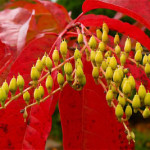
The flowers make their parting bows, making way for unusual fruit that looks like brown, wooden capsules and contain numerous pointy seeds.
Enjoyable as the year has been, the show really begins in fall as the tree’s generous leaves take on intensely beautiful shades of brilliant crimson, purplish-red and sometimes yellow.
Winter, spring, summer, fall: Oxydendrum arboreum shines as a lawn specimen, a garden feature, an ornamental addition to larger trees or as a clump in a wide open space.

 Retaining walls control erosion, create terracing, sculpt the landscape and provide ‘hardscapes’ with year-round appeal – all at the same time!
Retaining walls control erosion, create terracing, sculpt the landscape and provide ‘hardscapes’ with year-round appeal – all at the same time!
Sure, retaining walls look like simple stacked stone, block, timber, brick or concrete. Yet in reality good retaining walls are carefully engineered systems that wage an ongoing battle with gravity. They restrain tons of saturated soil that would otherwise slump and slide away from a foundation or damage the surrounding landscape. Flat-topped walls also make inviting spots to sit, create more planting possibilities and increase usable yard space by terracing sloped properties.
Along with sloped landscapes where water runoff causes hillside erosion, ideal locations for a retaining wall include spots downhill from soil fault lines and where the downhill side of a foundation is losing supporting soil or its uphill side is under pressure from sliding soil.
Although retaining walls are simple structures, a casual check around your neighborhood will reveal lots of existing walls that are bulging, cracked or leaning. That’s because most residential retaining walls have poor drainage, and many aren’t built to handle the hillside they’re supposed to hold back.
Such walls have to contain enormous loads; for example, a wall 4 feet high and 15 feet long could be holding back as much as 20 tons of saturated soil. Double the wall height to 8 feet and you’ll need a wall that’s eight times stronger to do the same job. Any wall that will be holding back a significant load is best left to a professional and any wall higher than 4 feet requires an engineer’s approval.
Frontier’ Landscaping’s installation team enjoys creating attractive walls using materials that suit a homeowner’s tastes and making them valuable landscape features. However, their No. 1 goal is to build you a solid retaining wall that performs its job excellently and that will go the distance. We can help in all aspects of your wall-building project including design, grading, excavation, drainage and wall construction.
Frontier Landscaping installs retaining walls, water features, patios and other landscape features throughout Clark County, Wash., Vancouver and the Portland Metro area.

Trading play area for puddle?
Excess water needs someplace to go and always follows the path of least resistance. This is great in the wild but can be a real problem for the homeowner.
Water drainage problems in the yard decrease property value and can lead to costly water damage to the house and other structures along with plant and turf damage. Heading off such damage by remedying draining issues is usually less costly than repairing the water damage itself.
To get a rough idea where the problems lie, take advantage of heavy rains to watch what happens to the water. Does it gush from the gutter and flood the flower bed or pool below the deck? Is there an area in the yard that becomes a swamp – or that remains swampy all year? Lawns and plants will die and/or become susceptible to disease and pest problems if they’re mired in too much water.
Does water course across the driveway or into the street during a hard rain or, worse yet, soak areas around your home’s foundation? In some cases the grade was not established correctly and did not take into account that the ground should slope down and away from the house.
There are many types of drainage options for use these days including catch basins, ditches, French drains, channel drains and others. Most drains are installed using gravity to move the water away but in some cases a sump pump and basin are used to move the water away from the wet area.
French drains are the most commonly used means of collecting, conducting and discharging water. This is a trench filled with gravel, sand or rock (depending on application) containing a perforated pipe that redirects surface water and groundwater away from an area. The perforated (“weeping”) pipe also allows small amounts to seep into the ground along the way.

Covered-over French drain line doubles as an attractive garden path.
French drains are primarily used to prevent ground and surface water from penetrating or damaging building foundations or behind retaining walls to relieve groundwater pressure. They are what is used in most septic fields.
During the next rain storm, round up some wooden stakes, a hammer, a pencil or two – and a rain poncho or umbrella! Sketch, mark, make notes so you’re aware of the main problem areas.
Keep an eye on trouble spots for the next several days. Where does the excess water disappear quickly and in which areas is it slower to disappear, taking eight hours or more to dissipate? This is helpful in determining which areas should be addressed first.
This is a job best left to professionals. Doing so will save you hours of planning, purchasing and very hard physical labor. It eliminates having to deal with gas, phone, electric and cable lines, roots and existing water lines.
Frontier Landscaping’s expert installation team will determine the best place to collect excess water, the best method and route to conduct it, and an appropriate discharge point. We do the clean-up, too!
And, with a professional, the job is guaranteed. Give us a call today and beat that water problem once and for all!
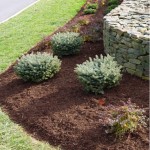 A simple layer of bark transforms the landscape, can cut water usage up to 50 percent – and lots more!
A simple layer of bark transforms the landscape, can cut water usage up to 50 percent – and lots more!
Bark, whether bark dust, chips, mulch or beauty bark, is produced out of chipped or shredded tree bark. Coarser forms are known as bark nuggets. They all decompose slowly and only need to be reapplied every few years.
Spread between plants in a landscape, bark holds in precious moisture, prevents erosion, insulates and protects plants in weather extremes. A layer discourages weeds and creates a more uniform, serene feel throughout the landscape that accentuates the beauty of your plantings. Here are a few professional pointers for success.
Start with good soil built up with humus, fertilizer and other amendments to foster a complete, living environment for your plants’ roots. Get the ground as weed free as possible. At this time you can apply a pre-emergent herbicide around non-food plants.
While fir is the cheapest, it also gives slivers and is orange in color. If you like to work in the dirt a lot or if kids will be playing in the area, hemlock is a better bet. It is richer looking, doesn’t give slivers and fleas don’t like it either. Then there is nugget bark, awesome for water runoff or windy areas.
As with all mulch, too much can injure plants by keeping the soil too wet and limiting available oxygen to the roots. A couple inches is  about right; don’t exceed four and leave a few inches of breathing room around the plant’s base. Occasionally, dig down through the mulch to make sure the soil has sufficient moisture and is not harboring pests.
about right; don’t exceed four and leave a few inches of breathing room around the plant’s base. Occasionally, dig down through the mulch to make sure the soil has sufficient moisture and is not harboring pests.
Improperly composted mulches can leach nitrogen from the soil and/or carry loads of viable weed seed; make sure of what you’re getting. Of course, if Frontier Landscaping is doing the job you needn’t worry!
Pile on the benefits in your landscape this year with a blanket of bark!

 Did you know you can absorb sound with plants of all sorts? Their leaves, branches, and wood entrap the vibrations. Best when employed as close to the noise source as possible, this method is commonly used for large scale applications.
Did you know you can absorb sound with plants of all sorts? Their leaves, branches, and wood entrap the vibrations. Best when employed as close to the noise source as possible, this method is commonly used for large scale applications. When sound waves strike a 5- or 6-foot masonry wall, it does not vibrate and they are reflected back toward the source. The sound waves that are higher up travel across the wall more readily, which is why plants along the wall and/or vines that grow over the wall enhance its effectiveness.
When sound waves strike a 5- or 6-foot masonry wall, it does not vibrate and they are reflected back toward the source. The sound waves that are higher up travel across the wall more readily, which is why plants along the wall and/or vines that grow over the wall enhance its effectiveness. Fountains and other water features provide a pleasant ‘white noise’ that is appealing to the human brain as a mask for undesirable noise. The most widely used method is a fountain that makes loud splashes. Coupled with other noise-reducing methods, even a smaller fountain becomes far more effective than you might think.
Fountains and other water features provide a pleasant ‘white noise’ that is appealing to the human brain as a mask for undesirable noise. The most widely used method is a fountain that makes loud splashes. Coupled with other noise-reducing methods, even a smaller fountain becomes far more effective than you might think.




 Clean up paths & patios
Clean up paths & patios With its modest profile and year-round interest, Oxydendrum arboreum – known commonly as sourwood – is one of the great trees for small spaces with a history of healing. The oval-shaped tree grows 20-25 feet tall.
With its modest profile and year-round interest, Oxydendrum arboreum – known commonly as sourwood – is one of the great trees for small spaces with a history of healing. The oval-shaped tree grows 20-25 feet tall.
 The flowers make their parting bows, making way for unusual fruit that looks like brown, wooden capsules and contain numerous pointy seeds.
The flowers make their parting bows, making way for unusual fruit that looks like brown, wooden capsules and contain numerous pointy seeds.
 Retaining walls control erosion, create terracing, sculpt the landscape and provide ‘hardscapes’ with year-round appeal – all at the same time!
Retaining walls control erosion, create terracing, sculpt the landscape and provide ‘hardscapes’ with year-round appeal – all at the same time!



